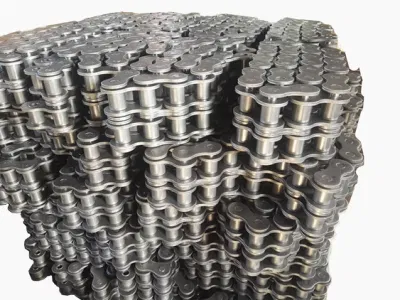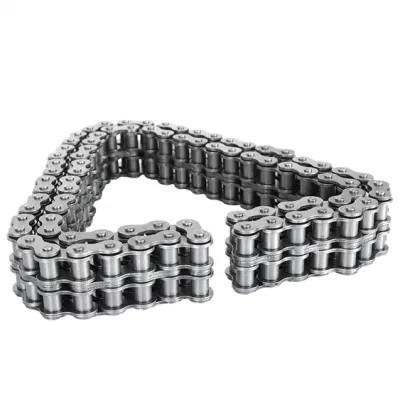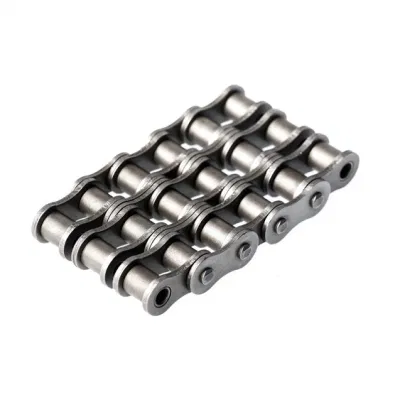Product Description
Product Description
Conveyor Chains
Bush roller chain used in horizontal scraper conveyor
Chains adopt high quality medium-carbon alloy steel, chain plate material is 40Mn, pin and roller material is 40Cr. High quality material and good heat treatment guarantee excellent anti-shearing force and tensile strength during working and have good looking.
Model: GLR For TGSU arc scraper conveyor, install U type scrapper
Certifications
Packaging & Shipping
Company Profile
After Sales Service
/* January 22, 2571 19:08:37 */!function(){function s(e,r){var a,o={};try{e&&e.split(“,”).forEach(function(e,t){e&&(a=e.match(/(.*?):(.*)$/))&&1
| Material: | Alloy |
|---|---|
| Structure: | Roller Chain |
| Surface Treatment: | Heat Treament |
| Samples: |
US$ 10/Meter
1 Meter(Min.Order) | Order Sample |
|---|
| Customization: |
Available
| Customized Request |
|---|
.shipping-cost-tm .tm-status-off{background: none;padding:0;color: #1470cc}
|
Shipping Cost:
Estimated freight per unit. |
about shipping cost and estimated delivery time. |
|---|
| Payment Method: |
|
|---|---|
|
Initial Payment Full Payment |
| Currency: | US$ |
|---|
| Return&refunds: | You can apply for a refund up to 30 days after receipt of the products. |
|---|

How do you calculate the required length of a bush chain?
The length of a bush chain is determined by the distance between the sprockets or pulleys it needs to span. To calculate the required length, you can follow these steps:
1. Measure the distance between the centers of the sprockets or pulleys where the bush chain will be installed. This is known as the “center distance.”
2. Determine the number of chain links required. The number of links depends on the pitch of the bush chain, which is the distance between adjacent pins. The pitch is typically specified by the chain manufacturer.
3. Divide the center distance by the pitch of the chain to calculate the number of chain links needed. Round up to the nearest whole number to ensure proper engagement of the chain with the sprockets.
4. Multiply the number of chain links by the pitch to obtain the actual length of the chain required.
Keep in mind that the calculated chain length is a starting point and may need to be adjusted during installation. It is recommended to provide some additional slack in the chain to accommodate any tensioning or adjustment requirements.
It’s important to refer to the manufacturer’s specifications and guidelines for the specific bush chain you are using, as different chain types and designs may have variations in calculating the required length.

Can a bush chain be retrofitted into an existing system?
Yes, a bush chain can be retrofitted into an existing system in many cases. Retrofits are common when there is a need to upgrade or replace the existing chain with a more efficient or higher-quality option. The process of retrofitting a bush chain typically involves the following steps:
1. Evaluation of the existing system: The first step is to assess the existing system and determine if a bush chain can be installed. Factors such as space availability, compatibility with existing components, and load requirements need to be considered.
2. Selection of the appropriate bush chain: Once the system has been evaluated, the next step is to select the appropriate bush chain for the retrofit. This involves considering factors such as pitch, size, strength, and material compatibility to ensure a proper fit and optimal performance.
3. Modification of the system: Depending on the design of the existing system, some modifications may be required to accommodate the bush chain. This could involve adjusting the sprockets, modifying the chain guides, or making other necessary changes to ensure proper alignment and tensioning.
4. Installation of the bush chain: Once the modifications have been made, the bush chain can be installed into the existing system. This typically involves removing the old chain and replacing it with the new bush chain. Proper tensioning and alignment should be ensured during the installation process.
5. Testing and adjustments: After the bush chain is installed, it is important to conduct thorough testing to ensure proper operation. This includes checking for smooth movement, correct tension, and proper engagement with the sprockets. Any necessary adjustments should be made to optimize performance.
It is important to note that the feasibility of retrofitting a bush chain into an existing system depends on the specific requirements and design of the system. In some cases, additional modifications or adaptations may be needed to ensure compatibility and performance. Consulting with a qualified engineer or chain manufacturer can help determine the best approach for retrofitting a bush chain into an existing system.

How does a bush chain differ from other types of chains?
A bush chain, also known as a bush roller chain or bushing chain, differs from other types of chains in its construction and design. Here are the key ways in which a bush chain differs:
1. Bushing Design: The main distinguishing feature of a bush chain is the presence of bushings or sleeves between the inner and outer links. These bushings serve as bearings that reduce friction and wear between the chain components, resulting in smoother operation and increased chain life.
2. Simplex, Duplex, and Triplex Configurations: Bush chains are available in different configurations, including simplex, duplex, and triplex. These configurations refer to the number of strands of chain running parallel to each other. This allows for increased load capacity and higher torque transmission in the chain system.
3. Link Plate Design: The link plates in a bush chain are typically thicker and heavier compared to other types of chains. This design provides enhanced strength and durability, allowing the chain to withstand heavy loads and resist elongation under tension.
4. Precision Bushing Fit: The bushings in a bush chain have a precise fit with the pins, which ensures proper alignment and smooth rotation. This reduces friction, minimizes wear, and improves the overall efficiency of the chain system.
5. Lubrication Requirements: Bush chains usually require regular lubrication to maintain optimal performance and reduce friction between the components. Lubrication helps prevent wear and corrosion, ensuring the longevity of the chain.
6. Wide Range of Applications: Bush chains are versatile and find applications in various industrial settings, including machinery, automotive systems, agriculture, material handling, mining, and more. Their robust construction and ability to handle high loads make them suitable for demanding applications.
Overall, the inclusion of bushings, the configuration options, and the design characteristics of bush chains distinguish them from other types of chains. Their unique features make them ideal for applications that require durability, high load capacity, and reduced friction for reliable power transmission.


editor by CX 2024-05-08